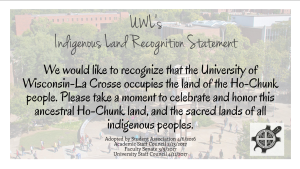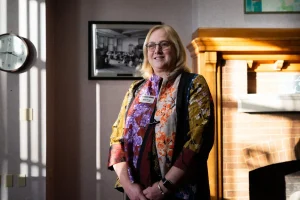Scholarship Expert Shares Her Secrets
February 10, 2018
Jocelyn Paonita Pearson, founder of www.thescholarshipsystem.com/home, which has helped award students almost a million dollars, virtually greeted a group of students Thursday night in the Wings Center. Within an hour, she was able to educate the students on a multitude of scholarship application tips.
“I came just to learn more about how to get scholarships and what scholarships you can trust,” UWL freshman Carly Chad stated.
Chad’s friend and fellow freshman Kailee Simon added, “I came to learn tips and tricks to put into an essay and what people look for.” The students were excited to find that their evening would be filled with such knowledge, along with more than they expected.
Pearson, an expert in scholarships, began her presentation with explaining her own experience of paying off college. During her time in school, she worked hard to never have to pay a dime of her money, and each year she was able to get more and more scholarship funding. Pearson was able to secure over six-digits of funds by continuously applying.
She didn’t realize until entering the work-force that her experience was nowhere near the norm. She witnessed her coworkers struggling to pay off student loans. She received calls from family and friends asking for tips and tricks on how they could follow in her path. This realization that high success with scholarships is abnormal led her to create the Scholarship System, which teaches students the process of applications.
“It does not matter if you have a perfect GPA,” Pearson told students, which included a crowd from both the University of Wisconsin-La Crosse and Viterbo. She described how she was an average student in high school and college, came from a middle-income household, and was not a star athlete.
She noted how the first lesson students must understand is grants, work studies and student loans. She stressed the importance of FAFSA, because the filing of such a form was the only way students had access to such opportunities. “Every student should submit a FAFSA,” she said. “If you haven’t, you definitely want to do that.”
She explained the difference between subsidized loans, where the government covers interest while the student is in school, and unsubsidized loans, where the loan accumulates loan throughout the student’s time in university and during the grace period following. Only taking subsidized loans, if possible, “can make a huge difference in what you owe in the end,” Pearson stated.
Scholarships and cash rewards should be the main goals of a student though. To find a scholarship, they should look towards merit based scholarships, The Book of Scholarships, scholarship search engines, office cabinets, local foundations, organizations, social media and Google. Local foundations are especially good places to look, as even though the amounts may seem small, there is usually limited competition.
Scholarships that are not scams are usually noticeable if they include a general information section, an involvement section, essays, miscellaneous materials section and an “anything else” section. If a scholarship is based on social media shares or is randomly drawn, then it likely should be avoided.
When writing the all-important essay, students need to show that they are a good investment, attempt to prove that they are unique, make sure it is well organized and have it proofread multiple times. Brainstorming topics can be completed smoothly by creating a list of ten values and chopping the list down quickly by only allowing for less than a minute to choose the most important values on the list.
“When writing these scholarship essays, you need to be creative,” Pearson explained. Students should work with both Mind Maps and outlines before actually working to write the full essay.
Pearson added that as more documents are created, it becomes easier to apply to scholarships each year. She explained that if a student seems to never get any scholarships, they may need to take a moment to perfect their own applications before continuing on.
Pearson was brought to students virtually by the University of Wisconsin-La Crosse, It Makes Cents office, and Viterbo University.






